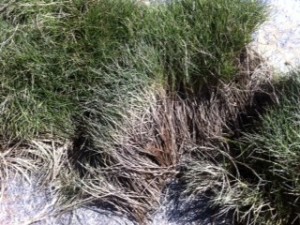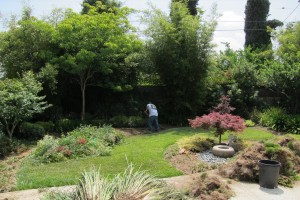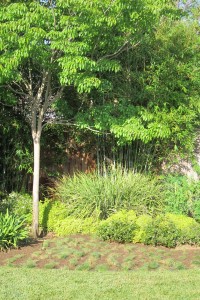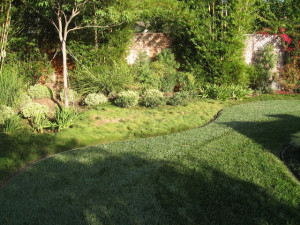Korean Grass- Zoysia tenuifolia makes a handsome, low growing ground cover. Although it has an attractive lawn like appearance, it is not a lawn substitute and it is not completely maintenance free. But it sure is attractive.
Zoysia can be planted as sod or by plugs.
Zoysia is very slow growing and can go dormant in the cool winter months. If it is installed as plugs, realize that it can take an entire growing season to fill in. Longer if you spaced the plugs more than 12 inches apart.
Zoysia can be attacked by disease
Zoysia does have an underground root system that can be aggressive and grow into the surrounding plantings
Installing or Repairing Your Korean Grass
If you have an old patch of Korean Grass that has become too thick or was damaged, it can be removed and replanted.
The attractive mounding habit that gives Korean Grass its personality forms because the grass gets “thatchy”. The fresh green leaves grow over and above a layer of thatch. If you pull the grass blades apart you will see this dried grass underneath. It can be very unsightly.
One of our clients sent me this picture today. It shows the green foliage above a layer of thatch. This does not make the grass “old”. It is just something that the grass does. The faster or more established the sod grows, the faster the thatch forms.

This client had a damaged area of Zoysia under the Tabebuia tree. While doing a detailed yard clean up and pruning, the Korean Grass was dug up and thrown into a pile, to be replanted later.
Note how thick the removed grass has become. We have experience mowing Korean Grass to remove thatch, but be warned that it takes several months for it to grow back, but end result is worth the wait. Just don’t do it the day before the the big backyard picnic.

Here the Zoysia that was dug up, was cut into small 5in x 5in pices called plugs and replanted. We cleaned out as much of the thatch as was reasonable and buried the root portion completely under ground. Only tufts of the Korean Grass foliage was left above grade. If you do not bury the roots completely, they will dry out before establishing themselves.
If you click on the picture to see a close up, it is obvious that much of the thatch is still showing. In this case we did not mind and like to see the plugs. If the plugs were given a short clipping and then buried, only the bare earth would show until the Zoysia foliage shows. It is also possible the plugs will not grow due to lack of photosynthesis for the root system.
Keep the plugs moist, not wet, until they begin rooting. Then cut back on watering to prevent the onset of disease.

Here is the final result. This picture shows the plugs as they have grown together to form a beautiful ground cover. It took a summer to fill in. It certainly was worth the wait.

To see more of this beautiful garden click on the image below or go to this link and enjoy the pictures.
https://picasaweb.google.com/114485009969381156543/ClaudiaJapaneseStyleGarden?authuser=0&feat=directlink
 |
| Claudia Japanese Style Garden |
